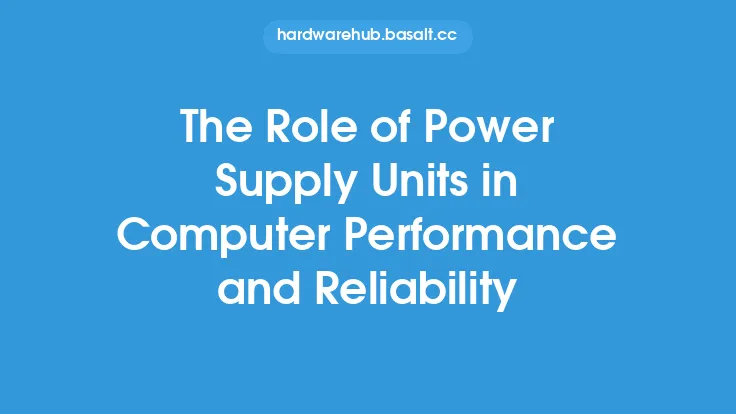When it comes to building or upgrading a workstation, one of the most critical components to consider is the power supply. A workstation motherboard's power supply requirements are unique and demanding, requiring a power supply unit (PSU) that can handle the high power demands of the system. In this article, we will delve into the world of workstation motherboard power supply requirements, exploring the key factors to consider when selecting a PSU for your workstation.
Introduction to Power Supply Requirements
A workstation motherboard's power supply requirements are determined by the total power consumption of the system, which includes the CPU, memory, graphics cards, storage devices, and other peripherals. Workstations often require more power than standard desktop systems due to the use of high-performance components, such as multi-core CPUs, high-end graphics cards, and large amounts of memory. The power supply must be able to provide a stable and efficient flow of power to all components, ensuring reliable operation and minimizing the risk of system crashes or data loss.
Calculating Power Supply Requirements
To determine the power supply requirements of a workstation motherboard, you need to calculate the total power consumption of the system. This can be done by adding up the power consumption of each component, including the CPU, memory, graphics cards, storage devices, and other peripherals. The power consumption of each component can be found in the component's specifications or datasheet. For example, a high-end CPU may consume up to 250W of power, while a high-end graphics card may consume up to 300W. The total power consumption of the system should be calculated using the following formula: Total Power Consumption = CPU Power + Memory Power + Graphics Card Power + Storage Device Power + Peripheral Power.
Power Supply Unit (PSU) Specifications
When selecting a power supply unit (PSU) for a workstation motherboard, there are several specifications to consider. The most important specification is the wattage rating, which indicates the maximum amount of power the PSU can deliver. A higher wattage rating does not always mean a better PSU, as it also depends on the efficiency and quality of the PSU. Other important specifications include the voltage rails, which determine the stability and reliability of the power supply. A good PSU should have multiple voltage rails, including 3.3V, 5V, 12V, and -12V, to ensure stable power delivery to all components.
Efficiency and Certification
The efficiency of a PSU is measured by its ability to convert AC power from the wall outlet to DC power for the system components. A high-efficiency PSU can reduce power consumption, heat generation, and noise levels. Look for a PSU with a high efficiency rating, such as 80 PLUS Gold or higher, which indicates a minimum efficiency of 90% at 50% load. Certification from reputable organizations, such as UL (Underwriters Laboratories) or ETL (Intertek), ensures that the PSU meets safety and performance standards.
Modularity and Connectors
A modular PSU allows you to connect only the cables you need, reducing clutter and improving airflow within the system. Look for a PSU with a modular design and a variety of connectors, including SATA, Molex, and PCIe power connectors. The number and type of connectors will depend on the specific requirements of your workstation motherboard and components.
Redundancy and Reliability
For mission-critical workstations, redundancy and reliability are essential. Consider a PSU with redundant components, such as multiple fans or power modules, to ensure continuous operation in case of a component failure. A PSU with a high mean time between failures (MTBF) rating, such as 100,000 hours or higher, indicates a high level of reliability and durability.
Power Supply Form Factors
Power supply form factors are designed to fit specific case sizes and types. The most common form factors include ATX, SFX, and TFX. ATX is the most common form factor, used in standard desktop cases. SFX and TFX are used in smaller cases, such as mini-towers or rackmount systems. Ensure that the PSU form factor matches the case size and type to ensure proper fitment and airflow.
Conclusion
In conclusion, selecting the right power supply for a workstation motherboard requires careful consideration of several factors, including power consumption, efficiency, certification, modularity, redundancy, and form factor. By understanding these factors and selecting a high-quality PSU, you can ensure reliable and efficient operation of your workstation, minimizing downtime and maximizing productivity. Whether you're building a new workstation or upgrading an existing one, a well-chosen PSU is essential for optimal performance and reliability.





